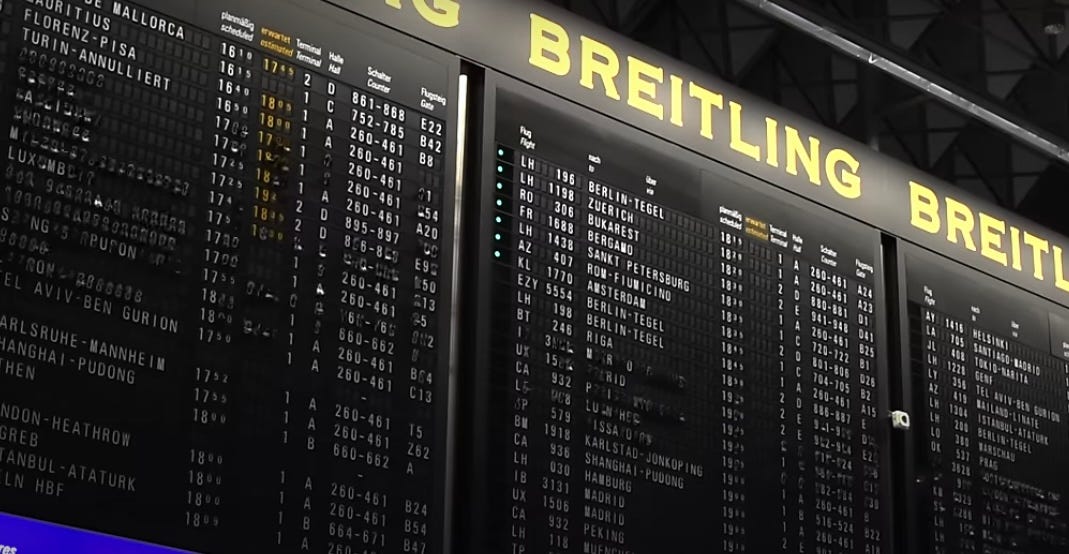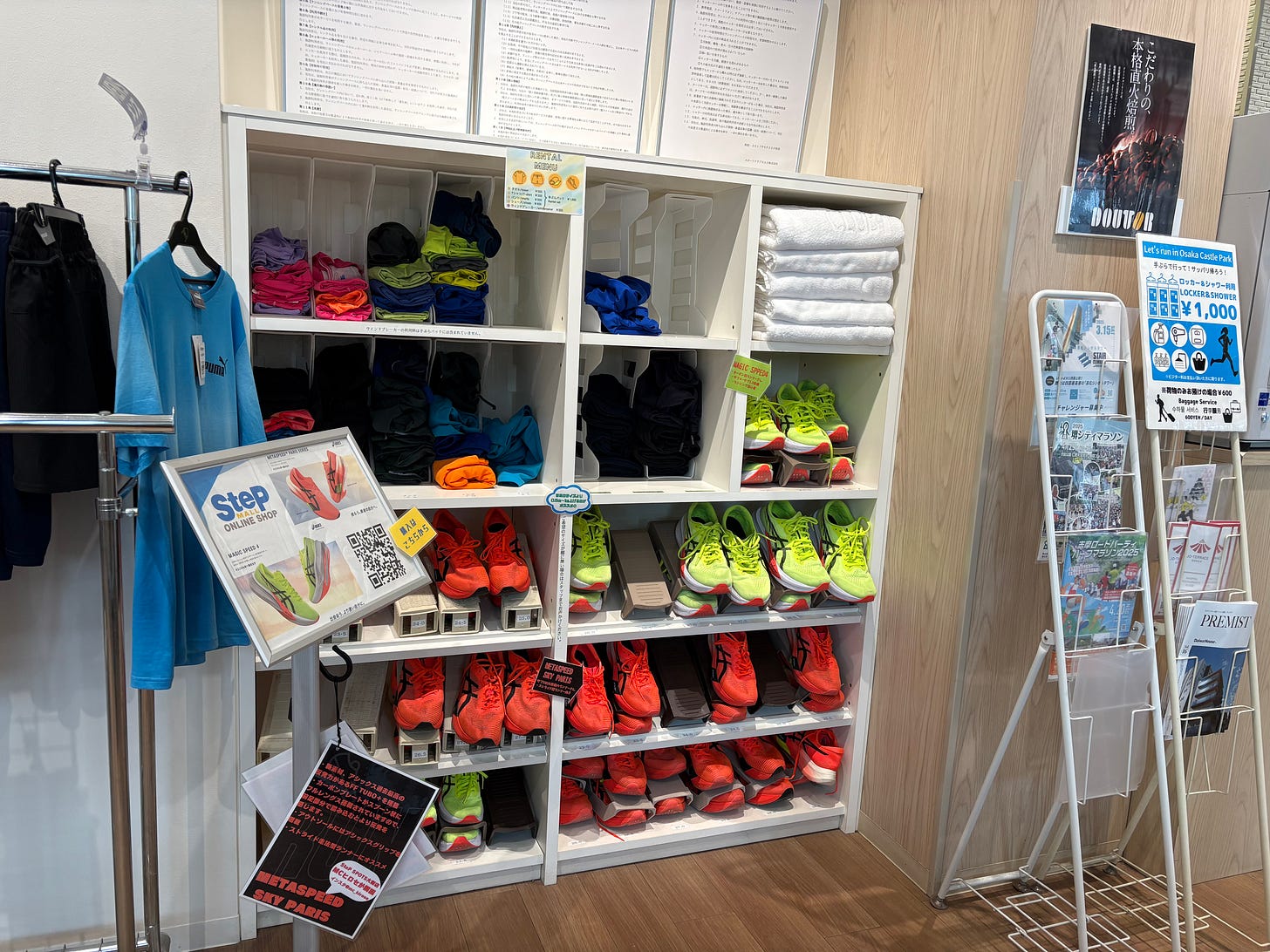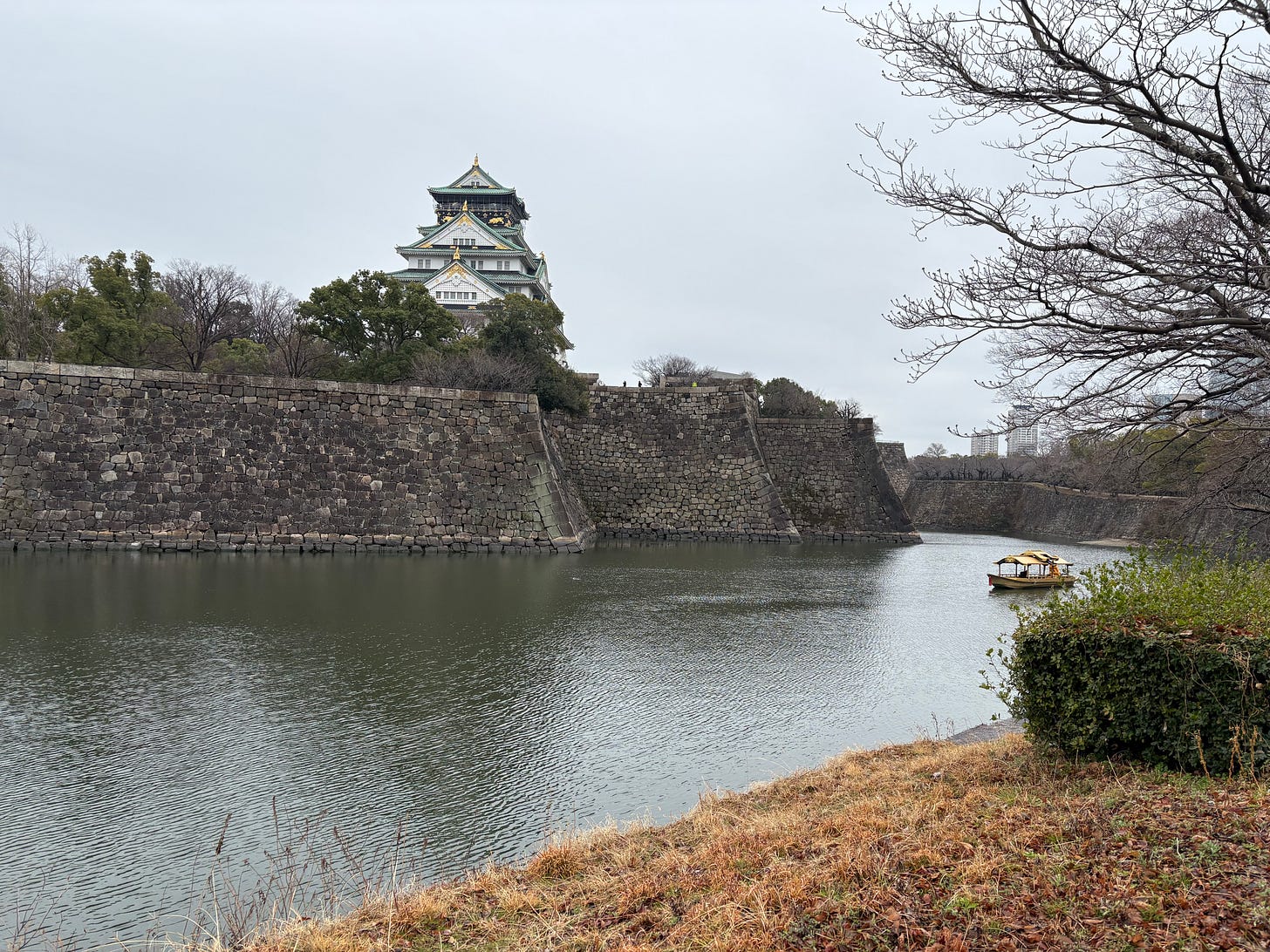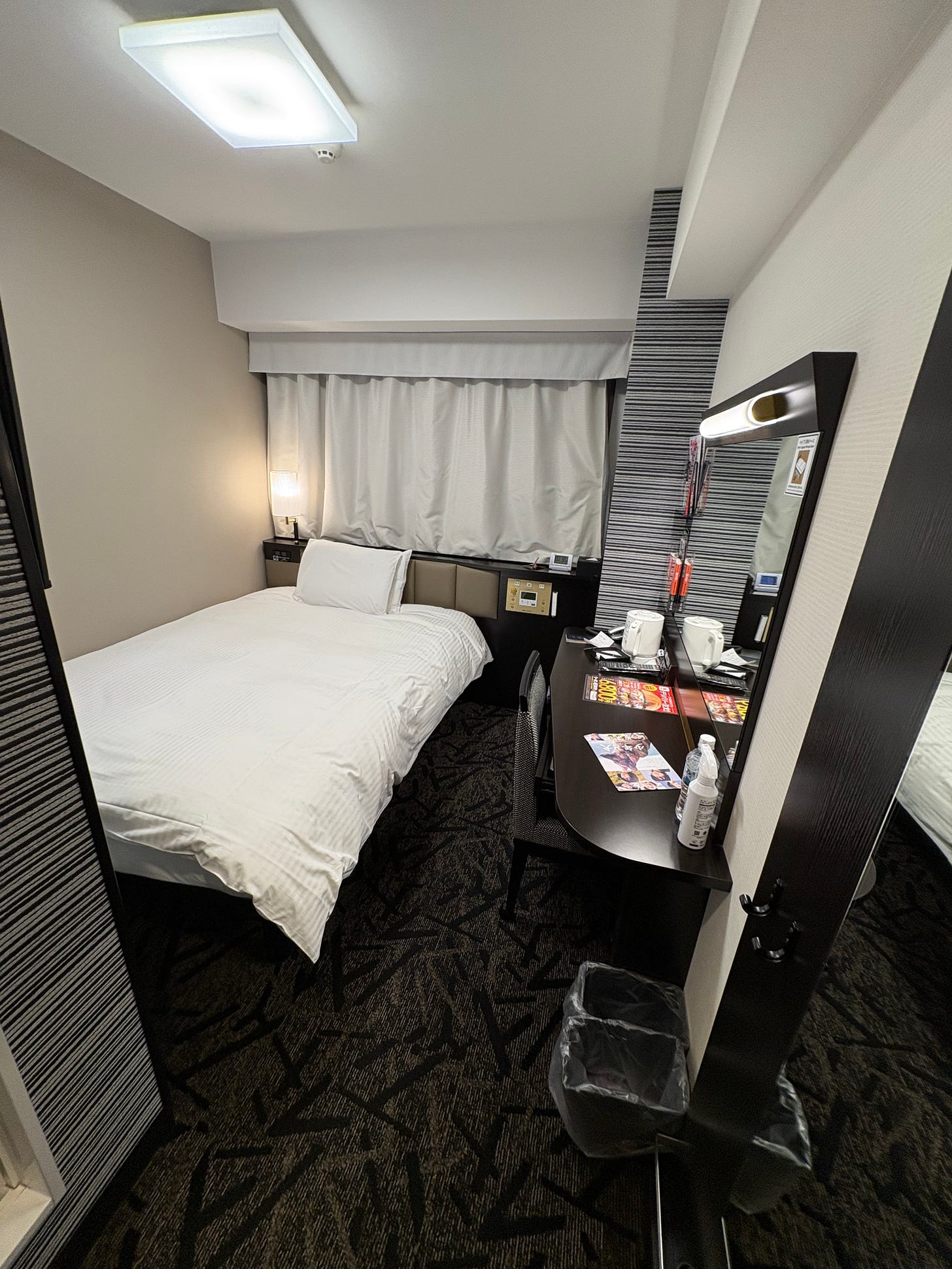Micro-trip report: A 10K run around Osaka Castle
24 hours in Japan — why I like micro-trips. Plus: A literal running base in Osaka, the versatility of the Hoka Clifton, and a controversial Japanese budget hotel chain.
I like to travel with a mission. But I’m not religious, so I could never be a missionary. Instead, I come up with goals of my own. Often it’s to run a half marathon. But here’s one I set myself the other day: Travel from my home airport in Santa Barbara, California, to Osaka, Japan, leaving on a Sunday morning, do a 10K run around Osaka Castle, and be back by Tuesday night. Plus eat good sushi while there and have some time to explore. Oh, I almost forgot to mention that travel in both directions has to be via Honolulu.
In defense of short trips
I am a defender of short trips to interesting places. Some people think there is no point in going somewhere unless you can linger awhile. And I get the case for longer trips, including the immersion factor and the economic benefit of amortizing the fixed cost of getting there over a longer number of days.
But short trips of, say, just three nights at your destination can involve a very focused presence. They force you to make the most of every hour. And when I return home, I’ve much of the feeling of a mental break that I’d expect from a somewhat longer trip. Maybe 80 percent of the fix for a fraction of the time.
In addition, short trips are easier to schedule and — if you have limited vacation time — allow you to spread your wings in different directions. And although they generally work out more per day if you apportion the flight costs, they will always be less expensive in absolute terms than a comparable longer trip simply because you’ve got fewer days’ worth of hotels and other expenses on the ground.
Moreover — to paraphrase the poet Lord Alfred Tennyson — it is better to have visited even a short while than never to have visited at all.
Why I also like micro-trips
But what about micro-trips? Trips so short that even a three-night stay seems leisurely? If you Google “micro trips,” you’ll find discussion of the concept but involving stays of a few days. I don’t consider those to be “micro.” They are simply “short.” A quintessential micro-trip — in my book — involves roughly 24 hours in your destination, sometimes less. Some people call these “extreme trips,” but I think that term is, well, extreme. Could two nights at the destination count as “micro?” Maybe, depending on the distance involved. It’s one of those things that’s hard to define rigidly, but where you know it when you see it.
Micro-trips can, of course, seem cost-prohibitive for the time spent if you don’t benefit from airline staff travel (as I am fortunate to do). But not necessarily. Within Europe, short-haul flights can whisk revenue passengers to contrasting cultures and foreign languages for ultra-low fares. You can even do day trips to another country. Even if you don’t live in Europe, you could do a micro-trip within the continent if, perhaps, you’re headed there on business and can stay an extra day.
Another way of rationalizing the economics of micro-trips is to add them as stopovers in what would otherwise be direct or nonstop journeys to somewhere else. On a trip from California to Cape Town the other day, my wife and I carved out a six-hour trip into the part of London where I grew up. Flying via London was a more interesting way of getting to South Africa than going to Atlanta to pick up a nonstop from there. Airlines like Turkish and Emirates have helped build up their hubs by offering micro-stays with hotels and tours for transiting passengers.
Economic factors aren’t, of course, the only reason most people don’t go out of their way to do micro-trips. Another is that these trips can involve spending more time in airplanes and at airports than at their destination. That’s a good enough reason for most people to not want to do it.
But I belong to a class of people known as an “avgeek” (short for “aviation geek”). I like airports (and airport lounges). I’m actually fairly mild on the avgeek spectrum. But I find airports a bit of a cocoon. They provide instant cover from any request from the outside. “Sorry, I’m about to get on a plane….” They allow you to pick your time zone — choose between departure or arrival time zone, or something in between — and eat and drink accordingly. If you have access to lounges, you can do so for “free” (forgetting for an indulgent moment whatever expenditure qualified you to use the lounge in the first place).
And the best airports feel like a global crossroads. You can be 10-15 hours from just about anywhere, and the mix of fellow travelers reflects that. Frankfurt still has a vintage giant electro-mechanical departure board where thousands of letters spin around with a rapid clackety-clack to spell out the names of cities from all continents, a marvel of engineering. But even the electronic screens that have largely supplanted them provide tantalizing glimpses of destinations.
Some airports score a lot higher than others when it comes to the crossroads factor. London Heathrow — maligned by many — does well in that regard. Somewhere like Dallas Fort Worth — as huge an airport as it is — is a bit, well, “meh.” Somehow a flight departing for Pittsburgh doesn’t have the same interest for me as one headed for Cairo, even if I’m not getting on either.
I generally enjoy flights, too. Even though I’ve taken many hundreds of long-haul intercontinental flights, I still feel a bit of a high — so to speak — from flying around the world. When planning a micro-trip, I pick dates and routes when, even if I’m unlikely to score a standby lie-flat seat, the back of the plane is unlikely to be too bad. Traveling on my own, I find long-haul economy class flights where I’ve got an aisle seat generally tolerable. And those with an empty one next to me — and ideally a row to myself — can be positively pleasant.
Another factor in favor of the micro-trip is that you need to bring very little stuff with you. I’m not just talking about not checking a bag. I never check bags regardless of trip length. I’m talking “personal item” only. It is quite liberating to have a light backpack as your only bag as you cross the world. You need never worry about overhead bin space. And when you leave the destination airport and take the bus or subway into town, you are instantly more absorbed into the city you’re visiting, not one of those identifiable tourists lugging wheeled bags through stations and streets.
Part of the fun of a micro-trip — for me at least — is planning it to get the most travel experience out of the least amount of time. And — in keeping with the zen of the micro-trip — with the least expense commensurate with reasonable comfort. The trip I’m about to describe cost me less than $140 in terms of what I spent on the ground in Japan. But, as narrated below, I slept well, ate well, and fulfilled my mission.
Osaka introduction
Depending on who you ask, Osaka is either Japan’s second or third largest city. With a population of 2.75 million, I think it is really in third place behind Tokyo and Yokohama. But some people lump Yokohama — with its population of 3.7 million — in with Tokyo, which it adjoins. Others, however, rank Osaka by treating it as part of the Keihanshin Metropolitan Area, which also includes the nearby cities of Kyoto and Kobe.
Either way, Osaka is a major port city and commercial center, and Japan’s second international aviation gateway after Tokyo. The 16th-century shogunate Osaka Castle is its main historical landmark. The castle is surrounded by a moat and park with plum, peach, and cherry-blossom trees. And it was there that I was headed on my micro-trip to the city.
Running around Osaka Castle
If you’re a runner visiting Osaka, the castle is, indeed, the place to go. It is surrounded by the biggest outdoor space in the city center with pathways that are great for running. In fact, the park authorities encourage runners by mapping out two suggested routes, the “Short Course” at 2.9 km and the so-called “Long Course” at 3.5 km.

There are some markings on the paths to help you follow these courses, but I soon found it was easy to accidentally stray off-course. So I ended up carving out my own course as I went along, which totaled 6.4 miles — or a little over 10 kilometers. The predefined ones were anyway too short, so I was always going to have to combine and add to them in order to reach my 10K goal.
Creating your own course can also take you closer to the castle itself. It occurred to me that maybe the authorities want the official courses to steer runners away from the crowds of tourists heading into the castle, but I was visiting on a wet Tuesday in March, so there weren’t too many hordes to avoid.
Osaka, like Tokyo, has a somewhat dispersed city center. And the area around Osaka Castle isn’t the most interesting or lively. Nonetheless, staying near the castle made sense to execute my plan. My flight to Osaka landed at 6:45 p.m., and my flight out was at 8:45 p.m. the following evening. My plan was to get up early, walk to the castle to do the run, and then head back to my hotel for a shower before checking out and then exploring more of the city.
Unfortunately, the weather forecast had begun to change as I was traveling to Japan. And when I woke up, it was raining quite heavily. Coincidentally, the last time I ran in Japan — when I did the Tokyo Legacy Half Marathon in 2023 — there was also heavy rain. I’m not necessarily averse to running in rain. It can be quite refreshing. But it was cold as well as wet that gray morning in Osaka, so the prospect of heading out as planned wasn’t that enticing.
Running Base — a literal base for runners
The forecast did indicate that the rains would dissipate soon after 9 a.m., but it was still coming down when that hour came, and radar suggested there was more to follow. So I developed Plan B — which actually turned out to be an interesting running/travel experience.
I’d heard that Japanese running stores sometimes have lockers and showers, and I discovered there was a place right at the far edge of the park surrounding the castle called Running Base (they identify themselves mostly using this English name, with the Japanese one in smaller letters underneath). This actually wasn’t so much of a store — though it did have some gear for sale — as a “base,” as the name indicates. There are not only showers and lockers, but a small café for runners.
So I was able to check out of my hotel at around 9:30 a.m., head over with my stuff to Running Base, and then sit it out in the café until the weather improved. I actually worked on this blog — my overdue report on the Phoenix Rock ’n’ Roll Half Marathon in January — while waiting and drinking hot chocolate. There was only one employee there for most of the time. She spoke a little English and was very welcoming.
If you are visiting Osaka without any running kit, you can rent ASICS shoes at Running Base as well as clothing and accessories. ASICS — headquartered near Osaka in Kobe — is Japan’s largest running company. I would have rented a pair of ASICS shoes to try them out, but they didn’t have my 12.5 U.S. size.
The versatility of Hoka Cliftons
I was traveling light and hadn’t packed dedicated running shoes. Rather, I was planning to run in my Hoka Cliftons, which I’d worn for traveling. The Cliftons aren’t my favorite running shoe — and certainly aren’t the fastest — but are an excellent versatile combo shoe that’s good for traveling and urban walking as well as running. So they are my choice for trips when I don’t want to pack a pair of running shoes and want to run but not race (although I did wear them for the Victoria Falls Half Marathon Relay last year, not wanting to lug my Nike Alphafly’s around during a 10-day trip to Zimbabwe and Namibia).
When I pack separate running shoes, they take up a lot of space, partly on account of the type I favor and partly because of my rather large feet. I envy my wife, who manages to pack seemingly endless pairs of shoes into her carry-on.
Like the somewhat similar Hoka Bondi, the Clifton is named after a beach in Sydney, Australia. It’s unclear why, since these aren’t ideal shoes to take to the beach, nor is Hoka an Australian brand.
I buy Cliftons in an all-black colorway, which adds to their versatility compared with the loud colors of some running shoes. Some airlines — not U.S. ones — include footwear in the dress code for non-rev staff travelers and can deny boarding to those wearing what might loosely be called “sneakers” or “trainers,” but I think a pair of all-black Cliftons can just about squeeze past any critical eye. (Update: All of that said, I do have a concern about how long they last. I bought a pair of Clifton 9’s last year, and the edges of the heels began to fray after a few months of not especially heavy use. They replaced those under warranty, but the same has happened to the replacement pair. Maybe the new Clifton 10’s are better in that regard.)
Getting going on the run
Eventually, the rain started to lighten up, so I got changed and put my stuff in one of the Running Base lockers (since this was a micro-trip, I had just the one “personal item” backpack). I wore my race shirt from the Tokyo Half to give me a bit of local street cred.
It was still raining lightly by the time I finally headed out at around 11:30 a.m., but it stopped before I finished. And as the weather improved and the sun peeked out, the park began to fill a little with more people out on midday strolls as well as a handful of other runners.
Japan is well known for its springtime cherry blossoms. It was too early to see anything close to full bloom, but some buds were beginning to open along the course I ran. A few excited off-season tourists took selfies in front of whatever signs of spring were there.
At times, I ran close to the castle and moats, and at others paralleled the perimeter roads. The park has its undulations. And a hazard of inventing your own course as you go along is that you can unexpectedly encounter stairs, which break your rhythm. I had to scurry down a long flight of steep stone steps at one point.
Returning to Running Base, I took a shower and got myself organized for the rest of the day. Although the rain meant I was running late, I still had several hours left to explore some of the city before merging with the late afternoon commuters and heading to the airport.
I paid just $6.82 for the locker and shower, plus another $2 or so for the towels. The hot chocolates were also $2. Japan, in general, can be relatively inexpensive these days, and Running Base is a fantastic deal (as well as super clean). If I were doing this trip again (as I might), I wouldn’t necessarily even plan to stay close to the castle, knowing that I could use Running Base — not my hotel — as a base for getting launched and cleaned up.
I believe there’s a similar place in Tokyo run by ASICS itself close to the Imperial Palace, another iconic running location. I hope to check that out in another micro-trip.
I wish there were Running Base equivalents in other cities to which I travel, including in the U.S. It’s a great concept for people wanting to do a run in some iconic urban location when they don’t have a place to change and get cleaned up nearby. Imagine, for example, having one close to Santa Monica Pier and the running paths that head south toward Venice Beach. Or close to New York’s Central Park or London’s Hyde Park.
But somehow, I just can’t see such places existing in the U.S. or U.K. There would be too many negatives. Not enough profit. Concern about vagrancy. Liability. And so forth.
APA Hotels: a controversial Japanese budget chain
There’s a genre of hotel in Japan often just referred to as “business hotels,” which focuses on providing an inexpensive, no-frills experience with small rooms but all the essentials. There’s not really a close equivalent in the U.S. In the U.K., the nearest might be something like Premier Inn, but even that isn’t quite the same.
The largest of the Japanese business hotel chains is APA. They have over 300 hotels, including over 20 in Osaka alone. But APA — a privately held company — can be a controversial choice. The reason has to do with the politics of its owner, Toshio Motoya, who is a vocal supporter of revisionist historical views espoused by Japan’s far-right about the country’s role in events leading up to World War Two. APA leaves literature in the rooms promoting these theories (which, fortunately, is all in Japanese).
Some people choose not to stay in APA hotels as they find the politics of its owner too distasteful. But I was feeling exhausted by U.S. politics at the time and didn’t have it in me to make “statement decisions” about where to stay in Osaka. And I was curious to see what the APA experience would be like, especially since the location of one of its properties was ideal and the price seemed rather remarkable.

The APA hotel I chose was the “No. 336 APA Hotel Osaka Temmabashi Ekimae,” located close to the castle. It was really everything I could have hoped for — comfortable enough, reasonably modern, clean, and just $45 for the night. The rooms were, indeed, pretty small. Think “small ship cabin” small. But I don’t mind small hotel rooms when I’m traveling on my own. I sleep in an enormous bedroom at home, so I get my big-room fix there. The APA room might be less ideal for a couple, however. Although the bed itself can fit two, there’s very little space outside of it.
The staff with whom I dealt were friendly and spoke a little English. There was even a Japanese public bath with both indoor and outdoor sections, which guests can use for free. (The rooms, of course, also have their own private bathrooms.) The public spaces at some APA hotels can be a little gaudy from pictures I have seen, contrasting with the simplicity of the rooms, but the lobby was fairly small and understated at this property. Breakfast is available, although I didn’t sample it.
While all APA hotels are priced at the value end of the scale, you shouldn’t expect rates like $45 as a matter of course. In Tokyo, depending on the property and time of year, you might have to pay more like $125 to $150.
At the lower end of the scale, APA can work out comparable to what you’d pay at some of Japan’s “capsule” hotels, those places in which you sleep in small pods without lockable doors and with shared bathrooms. Some capsule hotels are trying to up their game from being sanctuaries for drunken “salarymen” who have missed the last train home. I’d be curious to try one of the nicer ones out someday, but they can be hard to rationalize if you can get a business hotel for about the same or not much more.
In 2007, APA was embroiled in a scandal involving fake earthquake construction data linked to several of its hotels. Hopefully, that is now all behind it.
Would I stay at an APA hotel again? Based on my Osaka experience, I would. But I might also check out some of the rival chains without the political baggage, such as Sotetsu Fresa.
Other Osaka travel notes
Sushi recommendation: On the evening of my arrival, after checking into my hotel, I took the metro to the Nippombashi station and walked around the Dotonbori section of town, which is quite lively at night. Nearby, I had a late dinner at Sakae Sushi, which is located in a quiet street away from the throngs. At 10 p.m., the place was packed, the diners mostly sitting around a large rectangular-shaped bar in the middle of which the busy sushi chefs took orders from slips of paper on which people wrote their choices. There was a menu with photos and numbers, so you just write the number and quantity and place a series of small orders until you’ve had your fill.
My dinner — which was excellent — came to $25.45, including ample food and a couple of surprisingly good Asahi nonalcoholic beers (I was off alcohol for six weeks at the time, due to some interactions with heart meds).
Getting around: Osaka’s subway and train system is excellent and inexpensive. There is really no need to use taxis or Ubers. The system is quite easy to master, but you need to know a few things. One is that there are three different companies operating separate sets of lines — the Osaka Metro, Japan Railways (which has local routes in some cities as well as its long-distance services), and Nankai.
Buying tickets at stations can be a bit confusing, so your best bet is to use something called an ICOCA card, which you can load up with funds and tap as you enter and leave stations across all three transit systems. You can get a physical ICOCA card, but I found it simpler to add one to my phone in the Apple Wallet app. That way, you just tap your phone at the ticket barriers. You can also use the same card in other major Japanese cities.
Just remember that you can’t use your ICOCA card on the premium services between the Osaka airport and city center run by Japan Railways and Nankai (the Haruka Kansai AirPort Express and the Rapi:t [not a typo, that’s what it’s called] AirPort Express, respectively). You can, however, use them on regular trains to and from the airport run by both companies. The latter aren’t all that much slower and can prove equally or more convenient depending on where you are going as well as immersing you more quickly into everyday Osaka life. I used my ICOCA card on the Nankai AirPort Express, one of the regular trains (notwithstanding its “Express” designation), which was efficient, although crowded, in both directions.

Osaka airport: Kansai International Airport — or KIX, to use its three-letter identifier — is the city’s international airport. It is located on an artificial island in the middle of Osaka Bay. It opened in 1994 to relieve overcrowding at Osaka Itami Airport, closer to the city, which now only handles domestic flights.
KIX easily passes one of my threshold tests for how good an airport is, namely easy public transport access to the city it serves. Some of the trains from KIX continue on to Kyoto.
But it fares less well according to another of my criteria, the selection of lounges. Unless you’re traveling as a revenue Business Class passenger, the lounge options are slim. There are, in theory, three Priority Pass airside lounges, but these are really little more than dull waiting rooms, with the lightest of light refreshments (no alcohol or real food). If you are on the Priority Pass deal where you have a limited number of lounge visits without paying extra, you certainly don’t want to blow a visit on one of these. Even if you have unlimited visits, it’s barely worth the effort of visiting, except maybe to fill a water bottle. Neither of the two U.S. airlines that currently fly into Osaka — Hawaiian and United — operate their own lounges at KIX.
On the other hand, the landside part of the airport is better than most. This is on account of a large and bustling food court in Terminal 1. It’s quite easy to miss this, however, as it’s on a level of the airport in between the departures and arrivals ones and, even then, is a bit hidden away as I recall. But there’s a decent spread of options, including sushi. I believe there’s also a Priority Pass landside lounge with food and beer, but I couldn’t find it and ended up in the food court. I didn’t have much time airside before boarding my plane, but did notice one sushi option there as well.
I’ve heard some stories of long lines arriving and departing at KIX, but everything was pretty quick and easy during my visit in March.
Osaka micro-trip sum-up
I did fulfill my mission, not just in terms of the running but also in terms of fitting the entire thing — the travel to and from Japan included — into three days. My flight out of Santa Barbara was at 6:30 a.m. on Sunday morning, and I landed back there shortly before midnight on the Tuesday immediately after. My routing, for avgeek readers, was SBA-LAX-HNL-KIX and back in reverse. And, no, I didn’t feel wasted by the end of it.
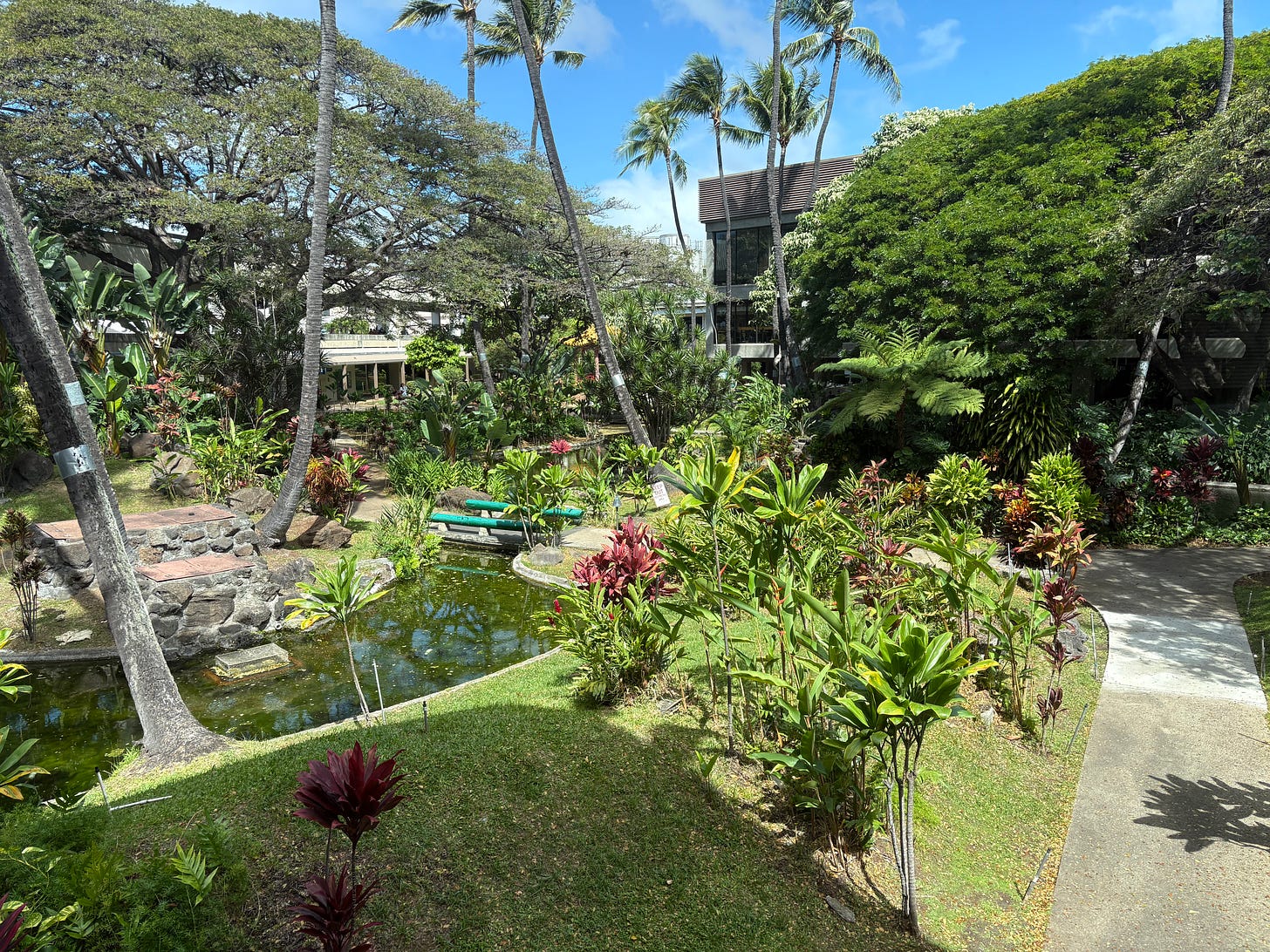
I had great flights in both directions on Alaska and Hawaiian (which are in the process of merging operations following Alaska’s acquisition, but with each keeping its separate identity). And I spent some time in the Honolulu airport, which I like with its breezy walkways and open-air, airside Japanese garden. Honolulu makes for a good segue from the USA mainland to Japan. But I’m going to save my takes about that and the aviation portion of this trip for another post, after I take the brand-new Hawaiian — or Alaska-Hawaiian — nonstop from Seattle to Narita, Tokyo (on its inaugural flight, if I get on). ✈️ 🏃
If you’ve stumbled across this post, please consider subscribing to this blog using the button below. It covers the intersection of running, travel, and aviation, and includes race reviews from around the world. Subscribing costs nothing — and never will — but supports the site. You’ll get an email every month or two with new posts.
For a list of other recent posts, click here.
And please share this post with others who may be interested, using this button:


